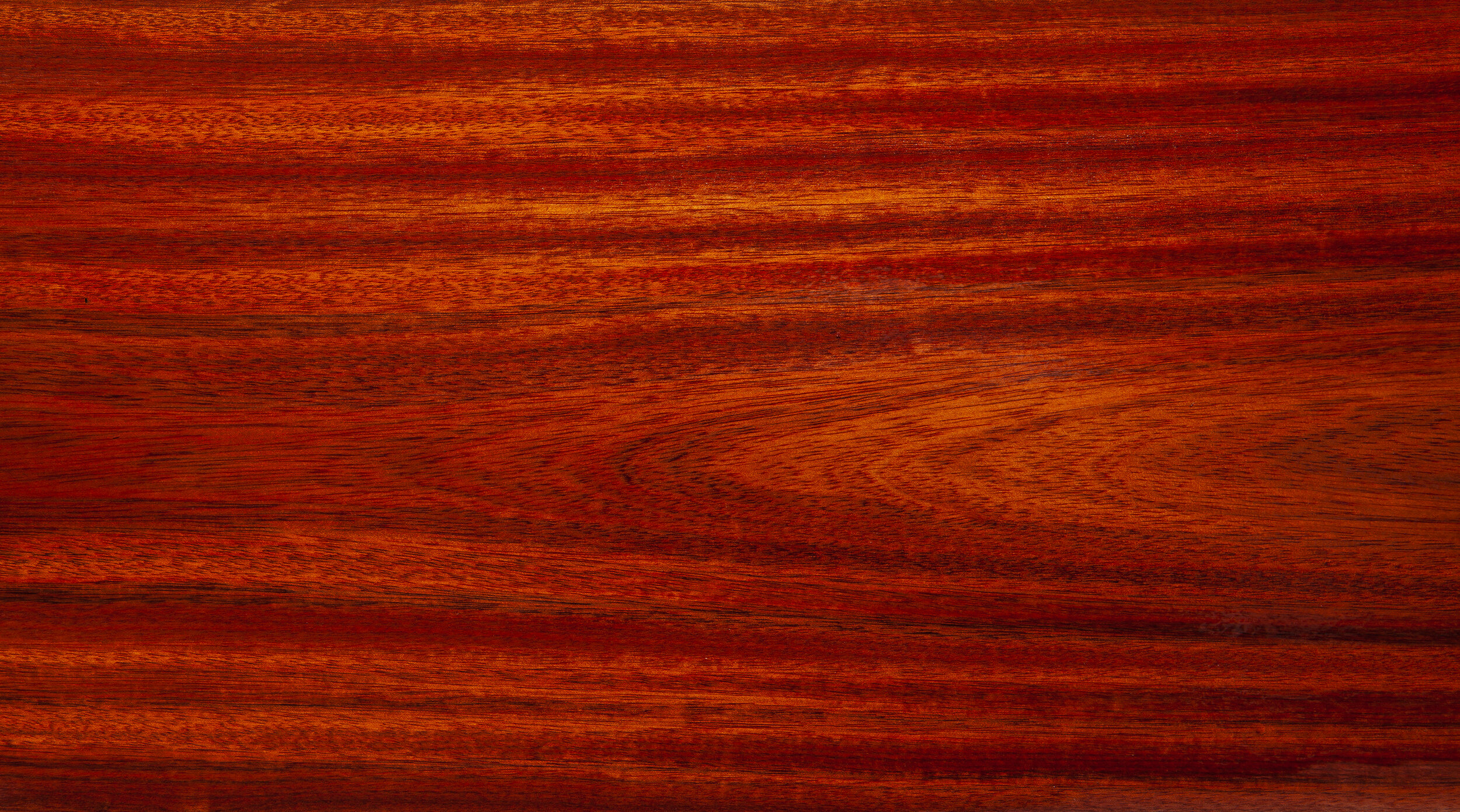Exotics
African Mahogany
ORIGIN: CENTRAL AND EAST AFRICA
African Mahogany is an exotic wood with a deep reddish brown color. The grain can be straight, but is typically interlocking. Working this wood is generally easy but tearing can occur when planing. It often has a shimmering figure. African Mahogany is popular for furniture, cabinetry, joinery, boat building and veneers.
WOOD TYPE: Tropical hardwood
TEXTURE Fairly: coarse and uneven
GRAIN PATTERN: Straight, interlocking
HEALTH RISKS: Dermatitis, respiratory problems, rhinitis and nasal cancer
COLOR: Reddish brown
Janka Hardness: 1100 lbf
Bloodwood (Cardinalwood)
ORIGIN: SOUTH AMERICA
Bloodwood is an exotic wood that is sometimes referred to as cardinal wood, for its obvious beautiful deep rose color. With age it's color does darken, but not significantly so it is a great wood to use in intarsia projects. The wood is very dense, with a tight fine, mostly linear grain.
WOOD TYPE: Tropical Hardwood
TEXTURE: Wonderfully smooth and even
GRAIN PATTERN: Straight, occasionally interlocking
HEALTH RISKS: Unknown
COLOR: Deep red, yellow-white sapwood
Janka Hardness: 2900 lbf
Wenge
ORIGIN: AFRICA
Wenge is an exotic wood with a natural growth range of the species is reported to be the open forests of Zaire, Cameroon, Gabon, the southern regions of Tanzania, and Mozambique. It is also found in the swampy forests of the Congo region. Wenge is reported to be a suitable substitute for Hickory for the production of sporting goods. It is moderately hard and resistant to wearing and marring. Strength qualities in compression parallel to grain are exceptionally high.
WOOD TYPE:Tropical Hardwood
TEXTURE:Medium to coarse
GRAIN PATTERN:Fairly straight
HEALTH RISKS:Dermatitis, giddiness, drowsiness, irritation to eyes, skin, respiratory system
COLOR:Dark-brown with near black veins
Janka Hardness: 1930 lbf
Purple Heart (KD)
ORIGIN: CENTRAL AND SOUTH AMERICA
Purpleheart is an exotic wood with mechanical properties of the wood are reported to lie somewhere between those of Greenheart and Oak. It is reported to have exceptional tolerance for shock loading. Purpleheart is reported to be highly desired by hobbyists and craftsmen who use the hard heavy wood in small projects.
WOOD TYPE:Tropical Hardwood
TEXTURE:Moderate
GRAIN PATTERN:Varies - Straight to wavy to interlocking
HEALTH RISKS:Dust can cause nasal inflation, nausea
COLOR:Purple
Janka Hardness: 2520 lbf
Paduak (African)
ORIGIN: WEST AFRICA
Padauk is an exotic wood that is a bright orange or almost crimson wood when freshly cut, but oxidizes to a darker, rich purple-brown over time - although it stays redder than Indian Rosewood. Slightly harder and heavier than Indian Rosewood it is a good wood in all respects - stable, and easy to work with. It often grows in small groups and is reported to be common in dense equatorial rain forests.
WOOD TYPE:Tropical Hardwood
TEXTURE:Moderately coarse, consistent
GRAIN PATTERN:Straight, slightly wavy, interlocking
HEALTH RISKS:Dust can cause skin and respiratory problems, eyelid swelling, itching, vomiting
COLOR:Red, darkening to purple-brown
Janka Hardness: 1970 lbf
Zebra Wood (KD)
ORIGIN: WESTERN AFRICA
Zebrawood is an exotic wood native to the Western African countries of Cameroon and Gabon. It is a hard wood, with a medium to coarse texture. The Zebra-like appearance is due to the light colored sapwood in contrast with the dark colored grain. Zebrawood is excellent for wood turning, veneer, furniture, pens, and knife handles. It works and finishes fairly, and has good gluing properties.
WOOD TYPE:Tropical Hardwood
TEXTURE:Moderately coarse, uneven
GRAIN PATTERN:Interlocking and wavy
HEALTH RISKS:Irritant to the eyes and skin, asthma, breathing difficulties, sensitizer
COLOR:Dark brown/black lines mixed with light brown bands
Janka Hardness: 1830 lbf
Rosewood (East Indian) (AD)
ORIGIN: INDIA
East Indian Rosewood is an exotic wood native to the Southern India peninsula, and is prized for its use in custom pool cues, furniture, and cabinetry. The color varies from golden brown to dark purple brown, with a unique striped figure. It is hard and dense, with a coarse texture and good stability. Although moderately difficult to machine or work with hand tools, East Indian Rosewood is excellent for wood turning and veneer, and finishes extremely well.
WOOD TYPE: Temperate Hardwood
TEXTURE: Texture is typically fine and even
GRAIN PATTERN: Straight
HEALTH RISKS: Not known
COLOR: Clear yellow to tan, pale-olive
Janka Hardness: 2440 lbf
Mora - Yellow (KD)
Origin:
Northeastern South America
Pieces with interlocked grain can be difficult to work, frequently resulting in tearout during machining operations. Mora also has a pronounced blunting effect on cutting edges.
Mora can have an unpleasant and sour odor while being worked
WOOD TYPE: Tropical Hardwood
TEXTURE: medium to coarse texture
GRAIN PATTERN: Has a straight to interlocked grain
HEALTH RISKS: has been reported to cause respiratory irritation
COLOR: light to medium reddish brown
Janka Hardness: 2300 lbf
Canarywood (Tarara) (KD)
ORIGIN: SOUTH AMERICA
Canarywood is an exotic wood that is yellow to orange in color, typically variegated with light to dark red streaking. It has a medium to high luster. It can be some what variable in density, it is mostly a hard, heavy and strong wood. Works very easily with both hand and power tools and finishes very smoothly. An exceptional exotic wood from South America.
WOOD TYPE: Temperate Hardwood
TEXTURE: Texture is typically fine and even
GRAIN PATTERN :Straight
HEALTH RISKS: Not known
COLOR: Clear yellow to tan, pale-olive
Janka Hardness: 1520 lbf
Chechen (Caribbean Rosewood) (KD)
ORIGIN: Caribbean
Fairly easy to work, but tearout may occur when machining pieces with interlocked grain. Glues and finishes well, though because of its density and tendency to split, nails and screws should be pre-bored.
WOOD TYPE: Tropical Hardwood
TEXTURE: Fine to medium
GRAIN PATTERN: Straight, gentle wave, likely to have interlocking grain
HEALTH RISKS: Most common reactions simply include eye and skin irritation
COLOR: Dark, deep reddish-brown, lighter and darker strips
Janka Hardness: 2200 lbf
Ebiara (Red Zebra) (KD)
Origins
West Africa
Generally easy to work with hand or machine tools, though planing or surfacing interlocked grain may result in tearout, particularly on quartersawn surfaces. Glues, turns, and finishes well.
WOOD TYPE: Tropical Hardwood
TEXTURE: fairly coarse texture and good natural luster
GRAIN PATTERN: tends to be interlocked, though it can be straight
Color:
Heartwood color ranges from golden yellow brown to a deeper reddish brown, frequently with darker black streaks and stripes
Janka Hardness: 1280 lbf
Shedua (KD)
ORIGIN: IVORY COAST OF AFRICA
Shedua trees can grow to a height of 150 feet, with trunks 3 feet in diameter. Lumber finishes to a high luster and takes stains and finishes well. Due to its high silica content, some dulling of tools may be noticed.
WOOD TYPE: Tropical Hardwood
TEXTURE: Moderately Coarse
GRAIN PATTERN: Straight to interlocked
HEALTH RISKS: Dust can effect lung function.
COLOR: Light golden brown to reddish brown
Janka Hardness: 1330 lbf
Bocote (Mexican)
ORIGIN: CENTRAL AMERICA, WEST INDIES
Bocote is an exotic wood native to Mexico, Central America, and the West Indies. It features a wide range of grain patterns from straight to wild, with curved lines and swirls. The color ranges from golden brown to tan to golden yellow. It is a hard, heavy, and dense wood, strong and stiff, with a medium texture. Mainly used for custom pool cues, cabinetry, veneer, furniture, inlays, knife handles, and pens. It polishes well with wax or polyurethane, and will take a moderately high natural gloss.
WOOD TYPE: Tropical Hardwood
TEXTURE: Medium
GRAIN PATTERN: Straight to wild, curved lines and swirls
HEALTH RISKS: Not known
COLOR: Golden brown, tan, golden yellow
Janka Hardness: 2010 lbf
Chakte Viga (Paela) (KD)
ORIGIN: MEXICO
Chakte Viga is a tropical hardwood from Mexico. The heartwood color varies slightly from pale to rich reddish orange. Chakte Viga is sometimes referred to as Paela. The grain is typically straight, but can be interlocking. It is reported to have good tonal qualities and is popular in both instrument building and wood turning. The wood can darken with exposure to light.
WOOD TYPE: Tropical Hardwood
TEXTURE: Medium to fine
GRAIN PATTERN:Straight, sometimes interlocking
HEALTH RISKS: Unknown
COLOR: Light to dark orange
Janka Hardness: 2250 lbf
Iroko (Teak Substitute) (KD)
Origins:
Tropical Africa
Generally easy to work, with the exception of its interlocked grain, which may cause some tearout during surfacing operations. Also, deposits of calcium carbonate are sometimes present, which can have a significant dulling effect on cutters. Iroko glues and finishes well.
Wood Type: Tropical Hardwood
Texture:
medium to coarse texture
Grain:
open pores and an interlocked grain
Health Risks:
Usually most common reactions simply include eye, skin, and respiratory irritation. Iroko can also cause other health effects in sensitive individuals, such as asthma-like symptoms, boils, and hypersensitivity pneumonitis
Color:
Heartwood is usually a yellow to golden or medium brown, with color tending to darken over time. Pale yellow sapwood is clearly demarcated from the heartwood
Janka Hardness: 1260 lbf
Peruvian Walnut (KD)
ORIGIN: CENTRAL AND SOUTH AMERICA
Peruvian Walnut has a dark brown appearance and is commonly used in furniture and cabinetry. You may have eye, skin, and/or respiratory irritation while working with Peruvian Walnut or other members of the Juglans genus.
WOOD TYPE: Tropical Hardwood
TEXTURE: Medium/Coarse
GRAIN PATTERN: Straight
HEALTH RISKS: Common issues include eye, skin & respiratory irritation
COLOR: Dark Brown
Janka Hardness: 960 lbf
Marblewood
Origin
Northeastern South America
Heartwood is yellow to golden brown, with irregular brown, purple, or black streaks. Paler sapwood is about one inch thick and is solid yellow, lacking the contrasting streaks found in the heartwood.
Wood Type: Tropical hardwood
Texture: medium with open pores
Grain Pattern: Grain tends to be straight or slightly interlocked.
Health Risk: There have been no known adverse health effects associated with Marblewood
Color: Heartwood is yellow to golden brown, with irregular brown, purple, or black streaks.
Janka Hardness: 2,530 lbf
Goncalo Alves (Tigerwood)
ORIGIN: SOUTH AMERICA
Goncalo Alves is native to South America and ranges in color from light to deep reddish-brown. It is very hard and naturally rot resistant.
WOOD TYPE: Tropical Hardwood
TEXTURE: Fine to medium
GRAIN PATTERN: Straight to interlocked and wavy
HEALTH RISKS: Dust can affect lung function.
COLOR: Light to reddish brown.
Janka Hardness: 2160 lbf
Jatoba
Origin:
Central America, southern Mexico, northern South America, and the West Indies
Although it’s widely named “Brazilian Cherry,” (mostly among flooring sellers), it bears little relation to the domestic Cherry (Prunus serotina) that is found in the US, except perhaps that its natural color closely matches the common stained color of domestic Cherry that has been aged/stained reddish-brown as seen on some interior furniture.
Jatoba is exceptionally stiff, strong, and hard—representing a great value for woodworkers seeking high-strength, low-cost lumber.
Wood Type: Tropical hardwood
Texture:
medium to coarse
Grain Patterns:
typically interlocked
Health Risks:
Although severe reactions are quite uncommon, Jatoba has been reported to cause skin irritation
Color:
Heartwood varies from a light orangish brown to a darker reddish brown, sometimes with contrasting darker grayish brown streaks. Color tends darken upon exposure to light. Sapwood is a light grayish yellow, clearly demarcated from the heartwood.
Janka: 2690 lbf
Sapele
Origin: Tropical Africa
Sapele can be troublesome to work in some machining operations, (i.e., planing, routing, etc.), resulting in tearout due to its interlocked grain. It will also react when put into direct contact with iron, becoming discolored and stained. Sapele has a slight blunting effect on cutters, but it turns, glues, and finishes well.
Wood Type: Tropical Hardwood
Texture:
Fine uniform texture
Grain Patterns:
interlocked, and sometimes wavy
Health Risks:
Sapele has been reported as a skin and respiratory irritant
Color:
golden to dark reddish brown. Color tends to darken with age.
Janka: 1410 lbf




















